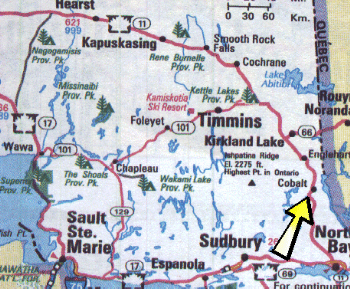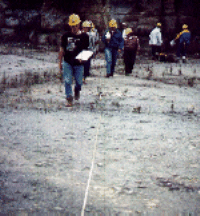Introduction
 Cobalt, Ontario, Canada, is a small town on highway 11, north of North Bay and south east of Timmins and Kirkland Lake in northern Ontario, Canada (See map at right). The town is well known in mining circles for it's past mining boom of silver and cobalt, for which the town is named. Silver was discovered in the summer of 1903, and by 1911, output of silver exceeded 30,000,000 oz. (850,000,000 g) per year. The mining of silver slowed in the 30's, picked up ahain in the 50's and then finally came to an end in 1993, when no active silver mines remained in the area. Unfortuately, the remains of the mining activities are of environmental and health concern even today. Tailings ponds (Tailings are the waste bi-products of the ore milling process, considered too poor in ore quality to be treated further. These tailings ponds are loaded with poisonous As minerals, which were associated with the silver-bearing ores. Huge quantities of Mercury (Hg) and cyanide are also found in the tailings, as they were used in the millimg process. None of these hazardous materials have been removed from the tailings, resulting in a health threat to the surrounding population. This risk is due to the fact that the tailings were just dumped into local lakes and streams (The environmental impact was unknown at that time).
Cobalt, Ontario, Canada, is a small town on highway 11, north of North Bay and south east of Timmins and Kirkland Lake in northern Ontario, Canada (See map at right). The town is well known in mining circles for it's past mining boom of silver and cobalt, for which the town is named. Silver was discovered in the summer of 1903, and by 1911, output of silver exceeded 30,000,000 oz. (850,000,000 g) per year. The mining of silver slowed in the 30's, picked up ahain in the 50's and then finally came to an end in 1993, when no active silver mines remained in the area. Unfortuately, the remains of the mining activities are of environmental and health concern even today. Tailings ponds (Tailings are the waste bi-products of the ore milling process, considered too poor in ore quality to be treated further. These tailings ponds are loaded with poisonous As minerals, which were associated with the silver-bearing ores. Huge quantities of Mercury (Hg) and cyanide are also found in the tailings, as they were used in the millimg process. None of these hazardous materials have been removed from the tailings, resulting in a health threat to the surrounding population. This risk is due to the fact that the tailings were just dumped into local lakes and streams (The environmental impact was unknown at that time). The geology of the area is so unique that the Carleton University Department of Earth Sciences has set up a two week field school in the area, where fledgling 2nd year geology and environmental science students can gain valuable field experience while examining and learning about the diverse geologic and environmental conditions that exist in the Cobalt area. The geology of the area is quite unique, with the entire area falling within the Lake Timiskaming Paleozoic Outlier. Environmental scientists can look first hand at the problems and solutions associated with large scale mining operations (Like these students, mapping out an outcrop in the picture to the left). Historic mining operations can be examined directly, along with the waste products that got left behind in the form of tailings ponds. Students gain valuable experience in mapping and other field techniques in a hands-on environment, like these students mapping out an outcrop in the area. For more information on Carleton's Earth Sciences Field Schools, click HERE. A plethera of geologic information can be found there for you to explore!
The geology of the area is so unique that the Carleton University Department of Earth Sciences has set up a two week field school in the area, where fledgling 2nd year geology and environmental science students can gain valuable field experience while examining and learning about the diverse geologic and environmental conditions that exist in the Cobalt area. The geology of the area is quite unique, with the entire area falling within the Lake Timiskaming Paleozoic Outlier. Environmental scientists can look first hand at the problems and solutions associated with large scale mining operations (Like these students, mapping out an outcrop in the picture to the left). Historic mining operations can be examined directly, along with the waste products that got left behind in the form of tailings ponds. Students gain valuable experience in mapping and other field techniques in a hands-on environment, like these students mapping out an outcrop in the area. For more information on Carleton's Earth Sciences Field Schools, click HERE. A plethera of geologic information can be found there for you to explore!
 Back to Index
Back to Index
 Geology of Cobalt
Geology of Cobalt
 Paleontology of Cobalt
Paleontology of Cobalt